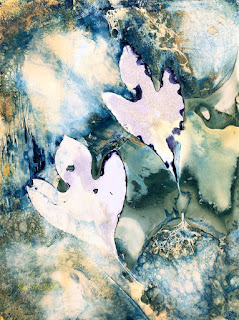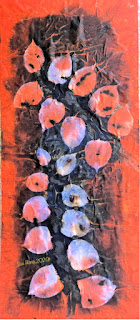The first three are on mineral paper, with pressed sassafrass leaves, and dish soap bubbles added just before covering with glass.
For the fourth one I used a red mulberry leaf. The all looked very promising right from the start.
It's early days of experimenting with bubbles on fabric. The fabric absorbs a lot of the water structure of the bubbles so it's a bit trickier and gives a more subtle effect. This one uses pressed oak leaves, along with a bit of Solarfast chemicals.
For the last one in this batch, I wanted to see what happened if I didn't smash the bubbles. I didn't think they would last long uncovered, but I have some glass cabinet doors left over from a remodel, and with the wood framing the glass sits up just a bit from the surface. The white spots here are the globs of bubbles. The leaves are more red mulberry.
Here are the prints after exposure but before rinsing out.
I am really starting to get the hang of working with mineral paper and I like it a lot.
You can see lots of bubble structure, along with a lot of swirly weirdness,
The oak print looks very gothic and mysterious at this point.
The one under the cabinet door got interesting. Some of the bubble structure remained, and got printed, but it also leaked out into a sort of corona effect.
Here are the finished prints. I find them to be extremely beautiful.
The colors, the swirls, the bubbles, the imprints at the edges of the leaves all thrill me.
Here's the oak print. Up close, you can see bubble structure. If I had been working with fresh leaves, I would have got more of an imprint in the interior of the leaf, but with the dried ones it's a blank resist. Since it is on cotton I can add vein structure with stitching as desired.
This last one has a lot of potential. I need to pin it up on the design wall and think about it a bit.
A reminder that you can also follow on your platform of choice:
Facebook page:http://www.facebook.com/suerenostudio
Twitter feed: http://twitter.com/suereno
Tumblr: http://suerenostudio.tumblr.com
Instagram: https://www.instagram.com/sue_reno_studio/
Twitter feed: http://twitter.com/suereno
Tumblr: http://suerenostudio.tumblr.com
Instagram: https://www.instagram.com/sue_reno_studio/














































